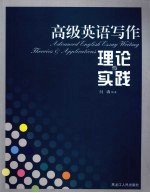

高级英语写作理论与实践PDF电子书下载
- 电子书积分:11 积分如何计算积分?
- 作 者:闫涛编著
- 出 版 社:哈尔滨:黑龙江人民出版社
- 出版年份:2009
- ISBN:9787207081841
- 页数:282 页
Chapter 1 A Brief Introduction to the Essay 1
1.1 Evidence,Idea,Essay 1
Evidence 2
Idea:Getting to the Heart of the Matter 2
Essay 4
1.2 Analysis,Interpretation,Reflection 6
Analysis 6
Interpretation&Reflection 7
Chapter 2 Analysis 9
2.1 The Nature of Analysis 10
2.2 Determining a Basis for Breakdown 10
2.3 Objectivity and Claims 11
2.4 Interpretation 12
2.5 Analysis and the Other Patterns of Inquiry 13
2.6 Analysis with a Purpose 14
2.7 Samples of Reading,Thinking&Writing 14
Text A from The Road from Coorain 14
Text B Neighborly Vultures 16
Text C Living Like Weasels 18
Text D The Bird of Paradise:The Hunter and the Poet 23
Chapter 3 Description 31
3.1 The Nature of Description 32
3.2 Creating a Lasting Impression by Selecting Details 32
3.3 Organizing Details 34
3.4 Using Figurative Language 34
3.5 Description with a Purpose 36
3.6 Description and the Other Patterns of Inquiry 37
3.7 Samples of Reading,Thinking&Writing 38
Text A from Moments of Being(1) 38
Text B from Moments of Being(2) 40
Text C The Seam of the Snail 41
Text D Love Sick 46
Chapter 4 Narration 53
4.1 The Nature of Narration 54
4.2 Sequence,Causality,and Effect 54
4.3 Defining Events 55
4.4 Selecting Events and Details 56
4.5 Moment in Time 58
4.6 The Narrator 58
4.7 Narration with a Purpose 61
4.8 Samples of Reading,Thinking&Writing 61
Text A from A Storm,the Cornfield,and Elk 61
Text B from Once More to the Lake 63
Text C Wolf Hunt 65
Text D Beauty:When the Other Dancer Is the Self 68
Chapter 5 Illustration 79
5.1 The Nature of Illustration 80
5.2 The Meaning of Illustration 81
5.3 How Illuatration Works:Inductive and Deductive Thinking 82
5.4 Using Illustration in Writing 83
5.5 Illustration with a Purpose 85
5.6 Selecting Examples 86
5.7 Illustration and the Other Pattenrns of Inquiry 86
5.8 Samples of Reading,Thinking&Writing 87
Text A from The Design of Everyday Things(1) 87
Text B from The Design of Everyday Things(2) 88
Text C from Writing Down the Bones 90
Text D English Is a Crazy Language 93
Chapter 6 Classification 99
6.1 The Nature of Classification 100
6.2 Selecting a Principle of Classification 101
6.3 Classification with a Purpose 102
6.4 Using Classification in Writing 106
6.5 Samples of Reading,Thinking&Writing 107
Text A from Invitation to Psychology 107
Text B from The Gift of Good Land 109
Text C The Best of Enemies? 111
Text D Mother Tongue 115
Chapter 7 Comparison and Contrast 123
7.1 The Nature of Comparison and Contrast 124
7.2 Comparison and Contrast with a Purpose 124
7.3 Establishing a Basis for Comparison and Contrast 124
7.4 Block Structure 126
7.5 Alternating Structure 128
7.6 A Special Case of Comparison:Analogy 130
7.7 Samples of Reading,Thinking&Writing 131
Text A from Emotional Intelligence 131
Text B Forty Ways to Look at Winston Churchill 133
Text C Athens and Sparta 135
Text D The Cosmic Calendar 138
Chapter 8 Cause and Effect 145
8.1 The Nature of Cause and Effect 146
8.2 Multiple Causes 147
8.3 Interactive Causes 147
8.4 Speculating about Effects 148
8.5 Using Cause and Effect in Writing 149
8.6 Cause and Effect with a Purpose 152
8.7 Cause and Effect and the Other Pattern of Inquiry 153
8.8 Samples of Reading,Thinking&Writing 153
Text A from Complications 153
Text B from Cleopatra's Nose 155
Text C The Double-Edged Ax of American Technology 156
Text D America and the Coffee Bean 161
Chapter 9 Process Analysis 165
9.1 The Nature of Process Analysis 166
9.2 Breaking Things Down Into Steps 166
9.3 Using Process Analysis in Writing 168
9.4 Process Analysis with a Purpose 171
9.5 Process Analysis and the Other Patterns of Inquiry 172
9.6 Samples of Reading,Thinking&Writing 172
Text A from Tender at the Bone 172
Text B from Sociology 173
Text C How to Put Off Doing a Job 175
Chapter 10 Definition 179
10.1 The Nature of Definition 180
10.2 Denotation and Connotation 181
10.3 Using Definiton in Writing 182
10.4 Ways to Define 182
10.5 Definition with a Purose 187
10.6 Definition and the Other Patterns of Inquiry 189
10.7 Samples of Reading,Thinking&Writing 189
Text A Scientific Concept 189
Text B Psychological/Religious Concept 191
Text C All Living Things Are Critics 194
Text D Criticism 197
Chapter 11 Argument 205
11.1 The Nature of Argument 206
11.2 Using Argument in Writing 207
11.3 Leading to a Conclusion 207
ll.4 Evidence 209
11.5 Logos,Ethos,Pathos 210
11.6 Fallacies 214
11.7 Samples of Reading,Thinking&Writing 217
Text A from Politics and the English Language 217
Text B from"Let's Go to the Tape" 218
Text C Have the Guts To Accept Gay Soldiers 220
Text D Declaration of Independence 223
Chapter 12 The Patterns in Their Natural Habitat 231
Text A Transfigurations 232
Text B Yes 236
Text C A Well-Regulated Militia 243
Text D Salvation 250
Text E I Have a Dream 254
Text F Reading the River 260
Appendix Finding Evidence and Documenting Sources 265
References 281
- 《SQL与关系数据库理论》(美)戴特(C.J.Date) 2019
- 《联吡啶基钌光敏染料的结构与性能的理论研究》李明霞 2019
- 《情报学 服务国家安全与发展的现代情报理论》赵冰峰著 2018
- 《英汉翻译理论的多维阐释及应用剖析》常瑞娟著 2019
- 《新课标背景下英语教学理论与教学活动研究》应丽君 2018
- 《党员干部理论学习培训教材 理论热点问题党员干部学习辅导》(中国)胡磊 2018
- 《剑桥国际英语写作教程 段落写作》(美)吉尔·辛格尔顿(Jill Shingleton)编著 2019
- 《虚拟流域环境理论技术研究与应用》冶运涛蒋云钟梁犁丽曹引等编著 2019
- 《当代翻译美学的理论诠释与应用解读》宁建庚著 2019
- 《语文阅读与写作教学研究》李玉红,陈晓玲,王芬著 2018
- 《市政工程基础》杨岚编著 2009
- 《家畜百宝 猪、牛、羊、鸡的综合利用》山西省商业厅组织技术处编著 1959
- 《《道德经》200句》崇贤书院编著 2018
- 《高级英语阅读与听说教程》刘秀梅编著 2019
- 《计算机网络与通信基础》谢雨飞,田启川编著 2019
- 《看图自学吉他弹唱教程》陈飞编著 2019
- 《法语词汇认知联想记忆法》刘莲编著 2020
- 《培智学校义务教育实验教科书教师教学用书 生活适应 二年级 上》人民教育出版社,课程教材研究所,特殊教育课程教材研究中心编著 2019
- 《国家社科基金项目申报规范 技巧与案例 第3版 2020》文传浩,夏宇编著 2019
- 《流体力学》张扬军,彭杰,诸葛伟林编著 2019
- 《办好人民满意的教育 全国教育满意度调查报告》(中国)中国教育科学研究院 2019
- 《人民院士》吴娜著 2019
- 《二十五史中的浙江人 24》浙江省地方志编纂委员会编 2005
- 《二十五史中的浙江人 15》浙江省地方志编纂委员会编 2005
- 《二十五史中的浙江人 20》浙江省地方志编纂委员会编 2005
- 《中国人民的心》杨朔著;夕琳编 2019
- 《野火·黎明哈尔滨 上》荀鹿著 2020
- 《中国十大出版家》王震,贺越明著 1991
- 《近代民营出版机构的英语函授教育 以“商务、中华、开明”函授学校为个案 1915年-1946年版》丁伟 2017
- 《二十五史中的浙江人 1》王志邦主编;浙江省地方志编纂委员会编 2005
